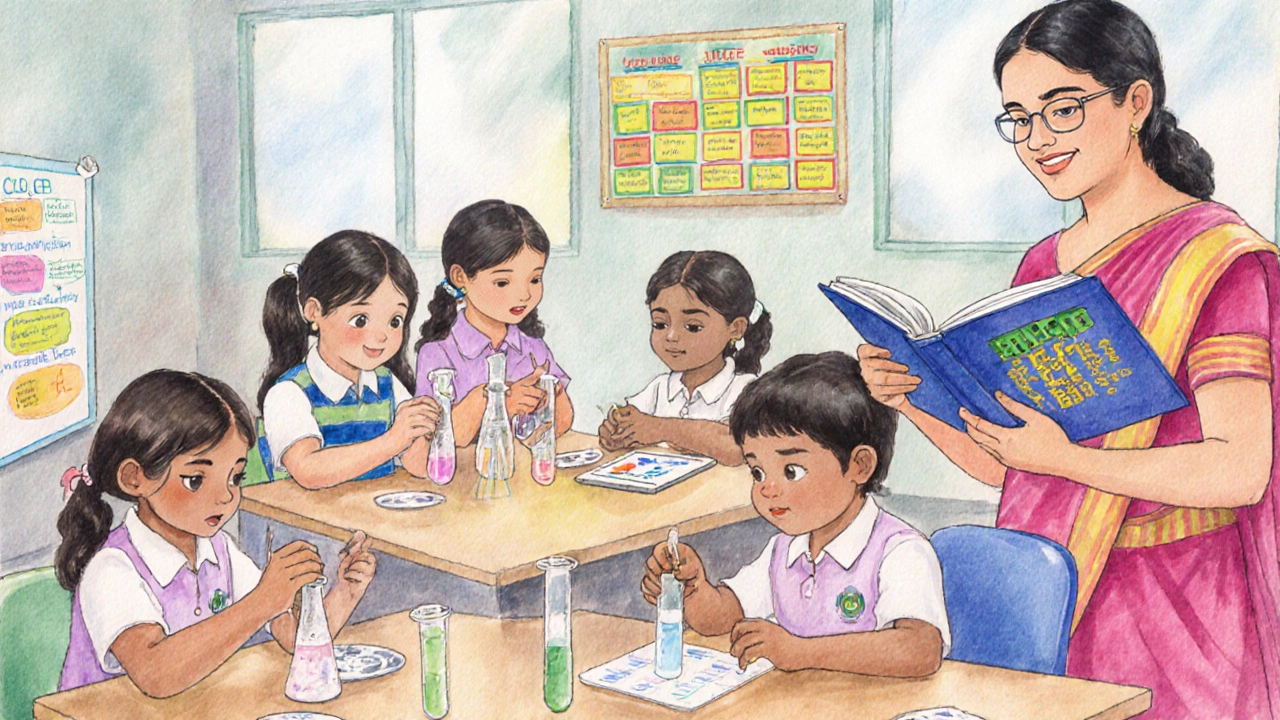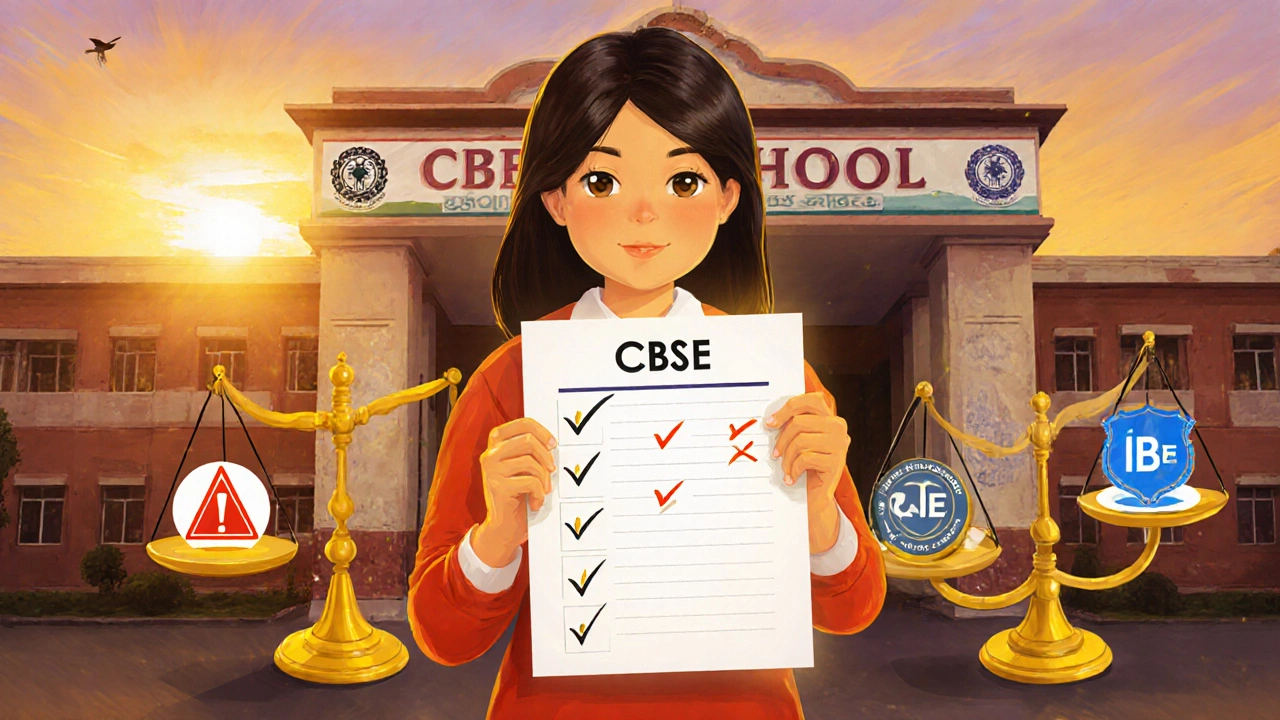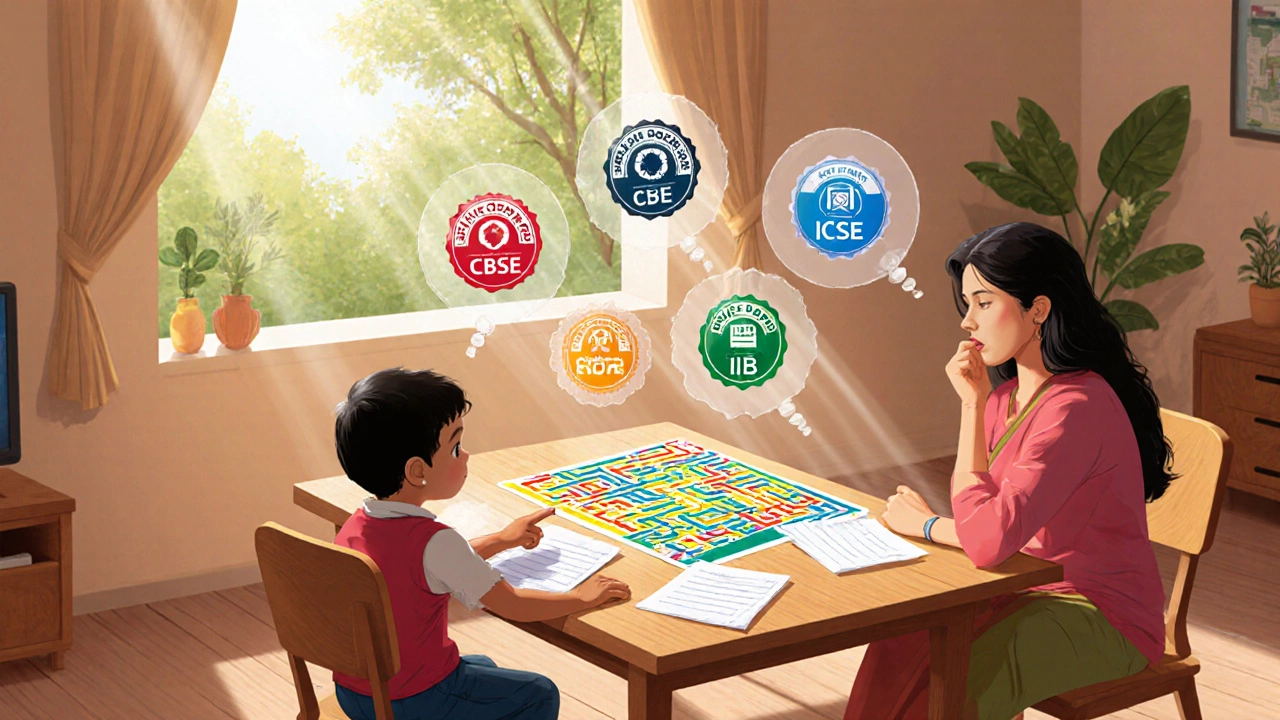Curriculum Matchmaker
This tool helps you determine which education board might be best suited for your child based on their learning style, academic goals, and family priorities.
Choosing the right curriculum for your child can feel like navigating a maze-every board promises better outcomes, but which one truly fits your kid’s learning style and future plans? In 2025 the debate still circles around the CBSE syllabus, yet parents also hear about ICSE, state boards, and even international programs. This guide breaks down what each option offers, how they differ on key factors, and hands you a practical checklist so you can decide with confidence.
What the CBSE Syllabus Actually Looks Like for Kids
When we talk about the CBSE syllabus is a nationally recognized curriculum designed by the Central Board of Secondary Education in India. It focuses on a balanced mix of core subjects-Math, Science, Social Studies, and Languages-paired with skill‑based activities like project work and co‑curricular clubs. For primary classes (Grades 1‑5) the board follows the National Curriculum Framework (NCF) 2005 guidelines, which emphasize experiential learning, reduced rote memorisation, and continuous assessment.
Key features of the CBSE primary framework include:
- Weekly Continuous and Comprehensive Evaluation (CCE) that blends quizzes, assignments, and class participation into a single grade.
- Subject‑specific textbooks that are updated every three years, ensuring content stays relevant.
- Emphasis on life skills-communication, critical thinking, and digital literacy-integrated into daily lessons.
Parents often appreciate the uniformity of CBSE across India, which makes school transfers smoother and aligns with national competitive exams like the JEE and NEET later on.
How Other Popular Syllabuses Stack Up
Before you label CBSE as the best, let’s compare it with the other top choices you’ll hear about.
| Curriculum | Core Focus | Assessment Style | Flexibility & Creativity | Future Pathways |
|---|---|---|---|---|
| CBSE syllabus | Balanced academics + life skills | Continuous & Comprehensive Evaluation (CCE) | Moderate-project work, labs, co‑curricular clubs | Strong for national competitive exams (JEE, NEET) |
| ICSE syllabus | In‑depth English, Science, Mathematics | Annual exams with detailed theory & practical | High-emphasis on analytical essays, lab reports | Good for overseas higher education prep |
| State Board syllabus | Regional language + basic core subjects | Mix of annual and term exams, often rote‑heavy | Low-limited extracurricular integration | Suitable for local college admissions |
| International Baccalaureate (IB) Programme | Inquiry‑based learning, global perspectives | Portfolio, internal assessments, external exams | Very high-student‑led projects, community service | Excellent for international universities |
| Cambridge Assessment International Education (CAIE) | British curriculum with IGCSE & A‑Level pathways | Structured exams with optional coursework | High-flexible subject choices, project work | Well‑recognized worldwide, strong for UK/US colleges |
Each board has its own philosophy. ICSE leans toward depth in language and science, while the State Board often prioritises local relevance. International programs such as IB and CAIE focus heavily on inquiry and creativity, which can be a big plus for kids who thrive on self‑directed projects.
Criteria to Decide Which Syllabus Suits Your Child
Now that you see the landscape, narrow down the choice by weighing these practical criteria:
- Learning style: Does your child enjoy hands‑on experiments, or do they prefer reading and writing? CBSE’s CCE blends both, whereas ICSE leans toward analytical reading, and IB favors project‑based learning.
- Assessment pressure: Frequent low‑stakes quizzes (CBSE) can reduce exam anxiety, while a single high‑stakes annual exam (State Board) might overwhelm some kids.
- Future academic goals: If you aim for Indian engineering or medical entrances, CBSE aligns directly with the exam format. For overseas studies, IB or CAIE give smoother credit transfers.
- Extracurricular opportunities: Schools following CBSE and international boards usually have clubs, sports, and art programs embedded in the timetable.
- Location & mobility: CBSE’s uniform syllabus across India (and many overseas Indian schools) simplifies transfers, whereas state boards vary state‑by‑state.
Ask yourself these questions with your child’s strengths and family plans in mind-this will point you toward the most fitting curriculum.

Step‑by‑Step Checklist for Parents
Here’s a quick, printable list you can use when touring schools or reviewing prospectuses.
- Confirm the board (CBSE, ICSE, State, IB, CAIE) and its grade‑wise curriculum map.
- Inspect sample textbooks or digital resources for Grades 1‑5.
- Ask about the assessment pattern: continuous vs annual, weight of projects.
- Check the availability of co‑curricular clubs, art, music, and sports.
- Verify teacher qualifications-are they trained in the board’s pedagogy (e.g., CCE for CBSE)?
- Look at the school’s past results in board exams and internal assessments.
- Consider the long‑term pathway: Does the school offer a clear transition to higher secondary under the same board?
- Discuss the school’s approach to digital learning-online labs, e‑textbooks, and coding basics are now common.
Cross off each item as you gather information; the board that consistently ticks most boxes will likely be the best fit.
Real‑World Stories: When CBSE Worked Best
Meet Aisha, a 7‑year‑old from Mumbai. Her parents switched from a State Board school to a CBSE‑affiliated one after noticing her curiosity for science experiments. Within a semester, Aisha’s class started weekly hands‑on labs, and her scores in practical assessments rose from 45% to 88% under the CCE system. The continuous feedback helped her teacher spot gaps early, and Aisha began enjoying math puzzles that aligned with the CBSE textbook’s problem‑solving approach.
Contrast that with Rahul, a 6‑year‑old who thrives on self‑directed projects. His parents chose an IB Primary Years Programme (PYP) school because the inquiry‑based model matched his love for exploring nature documentaries. While Rahul’s academic scores are solid, his confidence in presenting findings grew faster than it would have under a strictly exam‑driven board.
These anecdotes highlight that “best” isn’t one‑size‑fits‑all; it’s about matching the board’s strengths to your child’s personality.

Potential Pitfalls and How to Avoid Them
Every syllabus comes with challenges. Here’s what to watch for and actionable tips:
- Over‑reliance on rote learning (common in some State Boards): Request sample classroom activities that involve critical thinking or ask the school to share lesson plans that incorporate problem‑solving.
- Assessment overload (some CBSE schools cram too many quizzes): Clarify the weekly CCE schedule and ensure there’s balanced time for play and rest.
- Limited language exposure (ICSE can be English‑heavy for non‑English speakers): Look for bilingual support programs or additional language classes.
- Cost considerations (IB and CAIE often carry higher fees): Weigh the long‑term return on investment-international recognition versus local university entry.
Open communication with the school’s academic coordinator usually resolves most concerns before enrollment.
Final Thoughts: Making the Choice Confidently
At the end of the day, the “best” syllabus for kids is the one that aligns with three core pillars: your child’s learning style, your family’s future plans, and the school’s ability to deliver the board’s promises. CBSE remains a solid, balanced option for most Indian families, especially when you value nationwide consistency and a clear pathway to competitive exams. However, if your child craves deeper language work, consider ICSE; if global mobility or creative inquiry tops the list, IB or CAIE might be worth the extra investment.
Use the checklist, talk to teachers, and perhaps even sit in on a trial class. The right decision will feel less like a gamble and more like a thoughtful partnership with your child’s education.
What age does the CBSE syllabus start?
CBSE offers a formal curriculum from Grade 1 (around age 5‑6) through Grade 12. The primary stage (Grades 1‑5) follows the National Curriculum Framework guidelines.
How does Continuous and Comprehensive Evaluation (CCE) work?
CCE spreads assessment throughout the year via quizzes, assignments, project work, and class participation. Each component contributes a small percentage to the final grade, reducing the pressure of a single high‑stakes exam.
Is the CBSE syllabus better for competitive exam preparation?
Yes, because CBSE’s content and exam style closely mirror the format of national entrance exams like JEE and NEET, giving students a smoother transition.
Can a child switch from a State Board to CBSE midway?
Switching is possible, but parents should check the new school’s admission criteria and be ready for a short adjustment period, especially in subjects like Maths where the pacing differs.
What extracurricular options does CBSE provide?
CBSE schools often include sports, music, art, drama, and clubs for coding or robotics as part of the co‑curricular timetable, encouraging holistic development.
